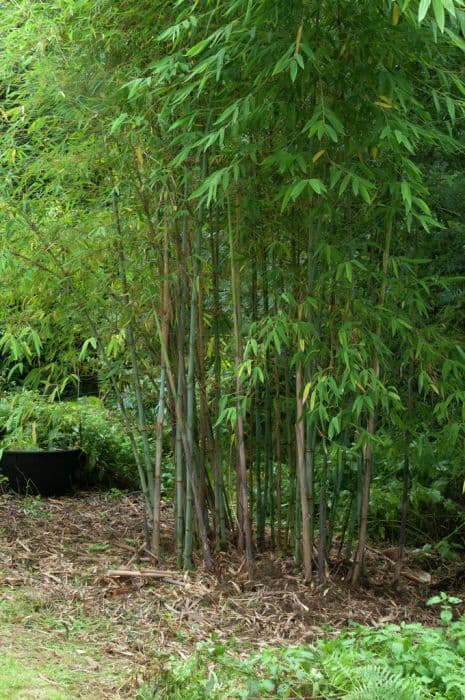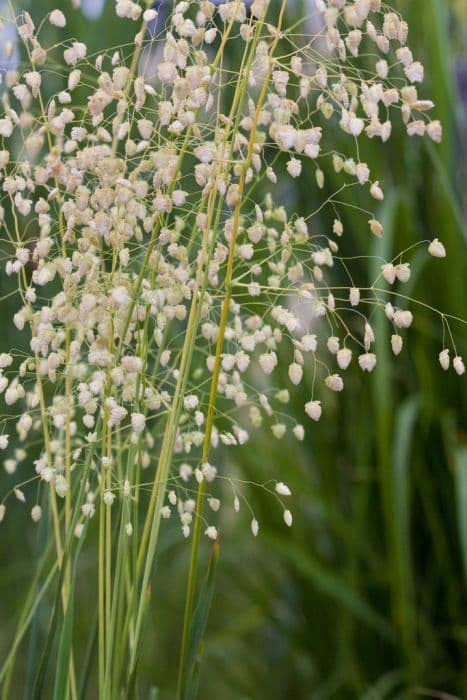Switchgrass 'Squaw' Panicum virgatum 'Squaw'










ABOUT
'Squaw' is a deciduous, clump-forming, perennial grass, to 1m tall. It has flat, linear, mid-green leaves, which develop purple tips and sometimes shades of red, orange and yellow in autumn. Airy sprays of tiny, pinkish-brown flowers are produced from mid-summer to early autumn
About this plant
 Names
NamesFamily
Poaceae
Synonyms
Switchgrass, Tall Prairiegrass, Wild Redtop, Thatchgrass, Squaw Grass
Common names
Panicum virgatum.
 Characteristics
CharacteristicsLife cycle
Perennials
Foliage type
Deciduous
Color of leaves
Green
Flower color
Varies
Height
4-5 feet (1.2-1.5 meters)
Spread
2-3 feet (0.6-0.9 meters)
Plant type
Grass
Hardiness zones
4-9
Native area
North America
Benefits
 General Benefits
General Benefits- Attracts Wildlife: Provides habitat and food sources for birds and beneficial insects.
- Erosion Control: Deep root systems stabilize the soil and prevent erosion.
- Drought Tolerance: Highly resilient in dry conditions, making it suitable for arid climates.
- Low Maintenance: Requires minimal care once established, reducing the need for water, fertilizer, and pesticides.
- Adaptability: Thrives in a wide range of soil types, from well-drained sandy soils to clay.
- Year-Round Interest: Offers visual appeal throughout the seasons with changing foliage and inflorescences.
- Ecological Support: Serves as a host plant for various moth and butterfly species.
- Bioenergy Crop: Potentially used as a biomass source for producing biofuel.
- Ornamental Value: Adds texture and movement to gardens and landscapes with its upright form and colorful panicles.
- Climate Resilience: Capable of adapting to changing climate conditions, making it a sustainable choice for future landscaping.
 Medical Properties
Medical PropertiesThis plant is not used for medical purposes.
 Air-purifying Qualities
Air-purifying QualitiesThis plant is not specifically known for air purifying qualities.
 Other Uses
Other Uses- Biofuel Production: Switchgrass is being researched and utilized as a source of biomass for bioethanol production due to its high yield and low input requirements.
- Phytoremediation: It can be planted on contaminated soils to stabilize the ground and assist in absorbing and filtering pollutants, thus helping in environmental cleanup efforts.
- Handicraft Material: The dried stems of switchgrass can be used to make baskets, mats, and other woven crafts.
- Erosion Control: The robust root system of switchgrass makes it an ideal plant for controlling soil erosion on slopes and riverbanks.
- Livestock Fodder: Although it is not the primary choice for fodder, switchgrass can be used as forage for livestock, particularly in areas where other fodder crops do not grow well.
- Wildlife Habitat: It provides excellent cover for wildlife, particularly as a nesting and foraging habitat for birds.
- Thatching Material: In traditional building practices, the dried grasses can be used for roofing material, providing a sustainable thatching option.
- Natural Dye: The plant can be processed to extract natural dyes for textiles and other materials.
- Sound Insulation: Because of its dense growth, switchgrass can be used in gardens and landscapes to reduce noise pollution.
- Decorative Displays: Dried switchgrass can be used in floral arrangements and decorative displays, offering a rustic and natural aesthetic.
Interesting Facts
 Feng Shui
Feng ShuiThe Switchgrass is not used in Feng Shui practice.
 Zodiac Sign Compitability
Zodiac Sign CompitabilityThe Switchgrass is not used in astrology practice.
 Plant Symbolism
Plant Symbolism- Adaptability: Switchgrass is known for its ability to adapt to a variety of soil types and conditions, representing the trait of being versatile and resilient in different environments.
- Growth: As a perennial grass that regenerates every year, switchgrass symbolizes continuous growth and renewal.
- Sustainability: Switchgrass is often used in conservation efforts and biofuel production, making it a symbol of sustainability and ecological awareness.
- Freedom: Its natural presence in prairies and open spaces can be associated with the concept of freedom and expansiveness.
- Grounding: With its deep root system, switchgrass embodies the idea of being grounded and having strong foundations.
- Resilience: The plant's ability to thrive in harsh environments and recover from disturbances like fire makes it a symbol of resilience and strength.
 Water
WaterFor the Switchgrass 'Squaw', water deeply to establish an extensive root system during the initial growth period. Once established, it is drought-tolerant and will require less frequent watering. Aim to water the plant every 7 to 10 days, providing about 1 to 1.5 inches of water each time. During periods of high heat or prolonged drought, you may need to water more frequently. It's best to check soil moisture levels before watering to avoid overhydration; the soil should be allowed to dry out slightly between waterings.
 Light
LightThe Switchgrass 'Squaw' thrives best in full sunlight, so it should be placed in a location where it can receive at least six hours of direct sun each day. It can tolerate some light shade, but too much shade can lead to weak growth and reduced vigor. The ideal spot for 'Squaw' is in an open area free of large trees or buildings that could cast significant shade.
 Temperature
TemperatureSwitchgrass 'Squaw' is hardy and can tolerate a wide range of temperatures, but it grows best in a range of 60 to 75 degrees Fahrenheit. It can withstand temperatures as low as -20 degrees Fahrenheit and as high as over 90 degrees Fahrenheit. To ensure healthy growth, avoid planting it in spots where temperatures drop below the freezing point for prolonged periods or where summer temperatures consistently exceed the upper tolerance level.
 Pruning
PruningSwitchgrass 'Squaw' benefits from pruning to maintain its shape and promote vigorous growth. Prune in late winter or early spring before new growth begins. This allows the plant to focus energy on producing fresh, healthy shoots. Cut back the foliage to about 4 inches above the ground. Pruning annually will help prevent the center of the plant from dying out and encourage a fuller appearance.
 Cleaning
CleaningAs needed
 Soil
SoilSwitchgrass prefers a well-draining soil mixture with the ability to retain some moisture. A mixture of loam, sand, and peat with compost added for fertility is ideal. The preferred pH range for Switchgrass is slightly acidic to neutral, around 5.8 to 7.0.
 Repotting
RepottingSwitchgrass, being a perennial grass, does not typically require frequent repotting. It should be repotted or divided every 3-4 years to refresh the soil and manage its growth.
 Humidity & Misting
Humidity & MistingSwitchgrass is adaptable to a wide range of humidity levels and does not require any specific humidity conditions, thriving in the ambient humidity levels found in most outdoor environments.
 Suitable locations
Suitable locationsIndoor
Provide full sun through a window and well-draining soil.
Outdoor
Plant in sunny spot, water regularly, tolerate poor soils.
Hardiness zone
4-9 USDA
 Life cycle
Life cyclePanicum virgatum 'Squaw', commonly known as Switchgrass 'Squaw', begins its lifecycle with seed germination, typically in the spring when soil temperature warms. Seedlings emerge and establish a network of roots while shoots begin photosynthesis. The plant enters a vegetative stage characterized by rapid growth of long, narrow leaves and sturdy stems that can reach up to 6 feet tall. As the plant matures, it enters the reproductive phase, usually in mid-summer, producing airy, branched flower panicles. After pollination, seeds develop and are dispersed in late summer to fall, completing the life cycle. During winter, the above-ground parts die back, but the plant remains alive through its perennial root system, ready to regrow the following spring.
 Propogation
PropogationPropogation time
Spring to Summer
Panicum virgatum 'Squaw', commonly known as Switchgrass, is primarily propagated through division, which is the most popular method for this ornamental grass. Propagation by division is typically carried out in the spring, as the grass emerges from dormancy, or in the fall, once the growing season has ended. To propagate Switchgrass by division, a mature clump should be dug up and carefully separated into smaller sections, ensuring that each section has a portion of the root system attached. These divisions should then be replanted at the same depth they were previously growing, and watered thoroughly to establish them in their new locations. This method allows for the quick and effective multiplication of Switchgrass, while maintaining the characteristics of the 'Squaw' cultivar.









